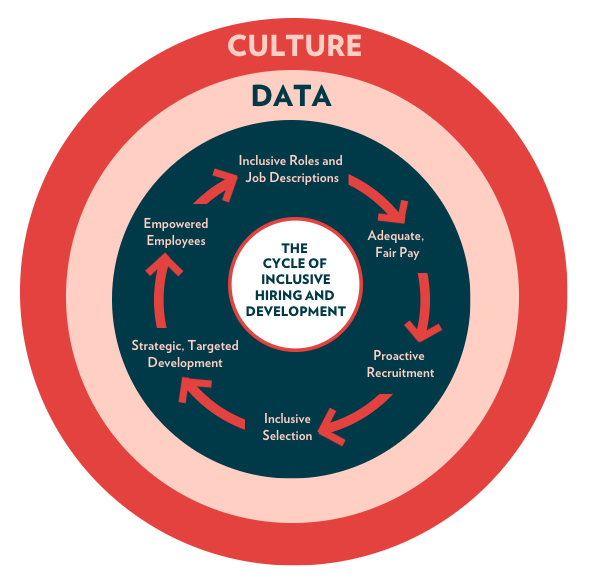How to Build a More Diverse, Inclusive, and Effective Policy Sector: Summary of Recommendations
This a brief summary of the recommendations included in the toolkit that identify the best practices on inclusive talent recruitment, hiring, and talent development for public policy organizations and government agencies or offices.
Our nation has a long history of excluding individuals and communities from the policymaking table—because of their race, ethnicity, or immigration status; their age, income, or educational level; or any number of other factors—even though they are often those who are most affected by our policy choices. For policy leaders who want to develop, influence, enact, and implement public policies to build a more just society, eliminating this systemic exclusion is crucial.
This toolkit identifies and shares best practices on inclusive talent recruitment, hiring, and talent development for public policy organizations and government agencies or offices. Below is a brief summary of the recommendations included in the toolkit. For additional context on each recommendation, please see the full toolkit here. To download a PDF version of this summary of recommendations, please see here.

1. Transparent, Actionable Data:
Collect and share data about staff diversity and inclusion internally and externally, and use this data to continuously improve organizational behavior
- Strategy 1. Collect and internally and externally report on staff demographics, including reporting by tenure, job seniority, and job function
2. Inclusive Roles and Job Descriptions:
Develop roles and job descriptions to be as inclusive and accessible as possible
- Strategy 1. Avoid unnecessary qualifications and requirements, particularly where such qualifications and requirements are likely to disproportionately and systematically exclude individuals from impacted communities, individuals of color, and individuals from other historically excluded communities
- Strategy 2. Intentionally develop some non-entry-level roles that do not require previous policy experience
- Strategy 3. Avoid inaccessible language and jargon in job descriptions—and make job listings easy to find and learn about
- Strategy 4. Be transparent about salary in job descriptions
- Strategy 5. Post openings publicly and fairly consider all applicants
3. Livable, Fair Pay:
Pay fair, livable wages to all employees, and do not create financial barriers to being successful within an organization
- Strategy 1. Provide a livable wage and benefits package that is as competitive as possible with other industries, including at the entry level
- Strategy 2. Do not require employees to pre-pay for work and travel expenses
4. Proactive Recruitment:
Recruit a broad and diverse applicant pool that includes individuals from impacted communities
- Strategy 1. Invest time and resources in outreach and recruitment efforts to identify new candidates
- Strategy 2. Conduct proactive outreach to organizations beyond the policy sector that work with impacted communities, and use creative outreach strategies
- Strategy 3. Collect and act on real-time applicant demographic data
5. Inclusive Selection:
Develop a selection process that minimizes bias and values lived experience, proximity, and potentia
- Strategy 1. Explicitly value lived experience and proximity to impacted communities as a form of expertise
- Strategy 2. Develop an accessible application that is not overly burdensome, but supplies information beyond a resume
- Strategy 3. Mitigate bias as much as possible upfront through training and an anti-bias cheat sheet
- Strategy 4. Ensure a diverse set of individuals are involved and have meaningful input at each stage of the hiring process
- Strategy 5. Strengthen consistency (and effectiveness) in hiring practices and and decisions, and minimize bias, through developing and utilizing common tools and rubrics for each stage of the process
- Strategy 6. Utilize performance tasks to evaluate ability/potential to do the job
- Strategy 7. Implement a variation of the Rooney or Mansfield Rules to ensure diversity in the pool
6. Relevant Professional Development:
Develop new skills and knowledge in employees as part of an organization’s core work
- Strategy 1. Identify and articulate the skills and knowledge needed for staff at various stages/in various roles, and provide professional development to build those skills
- Strategy 2. Support staff to identify additional external training opportunities that will strengthen their effectiveness (and pay for those opportunities)
- Strategy 3. Learn from new hires, and empower them to share their knowledge
7. Empowered, Supported Employees:
Empower and support individuals on staff who bring identities, backgrounds, and experiences that improve organizational diversity
- Strategy 1. Empower individuals at all levels to use a portion of their time to develop and drive their own policy agenda
- Strategy 2. Train managers as managers, and recognize management as a valuable skill
- Strategy 3. Create organization-wide opportunities for employees to provide feedback to organizational leadership, including anonymous feedback
- Strategy 4. Invest in mentorship within the organization, and facilitate and encourage the building of employees’ networks outside the organization
- Strategy 5. Create internal career ladders as opportunities for people to progress within the organization
- Strategy 6. Support staff who have trauma connected to their work
